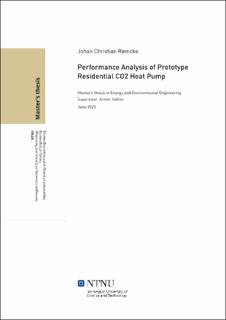| dc.contributor.advisor | Hafner, Armin | |
| dc.contributor.author | Rømcke, Johan Christian | |
| dc.date.accessioned | 2021-09-20T16:46:27Z | |
| dc.date.available | 2021-09-20T16:46:27Z | |
| dc.date.issued | 2020 | |
| dc.identifier | no.ntnu:inspera:57317478:35324680 | |
| dc.identifier.uri | https://hdl.handle.net/11250/2779615 | |
| dc.description.abstract | Varmepumper er i dag i svært liten grad benyttet til oppvarming av tappevann i norske boliger. Dette handler i stor grad om at det ikke har hensiktsmessig latt seg gjøre med de konvensjonelle varmepumpene som bruker syntetiske arbeidsmedier. Varmepumper med det naturlige arbeidsmediet CO2 kan levere varmtvannstemperaturer på 60-70 grader uten at det går på bekostning av ytelseskoeffisienten (COP). Kommersialisering av CO2 varmepumper til dette formål potensielt kunne være svært energibesparende for det norske bygningssektoren. En CO2 varmepumpe med kombinert tappevann- og romoppvarmings funksjon ble fra 2000 til 2004 utviklet ved NTNU-SINTEF. Varmepumpen har siden gjennomgått flere endringer, og har vært forskningsemnet for denne masteroppgaven. Hensikten har vært å analysere systemløsningene, realistisk energi/effektkapasitet, pålitelighet og instrumentering som muliggjør optimalisert drift.
Utførelsen av masterprosjektet har vært todelt; En praktisk del med eksperimentell testing og drift, og en teoretisk del med datamodellutvikling. I den første fasen av den eksperimentelle testingen ble CO2 varmepumpen satt opp i en testrigg hos Winns AS. Denne fasen besto av feilsøking, instrumentering og optimalisering. Varmepumpen ble deretter flyttet til en bolig for operasjonell testing. En dynamisk datamodell av varmepumpesystemet ble utviklet i modelleringsprogramvaren Dymola, støttet av referansemodeller utviklet i CoolPack og Simple One-Stage CO2 Cycle. Målet var å ha en gyldig modell som kunne brukes som et verktøy for systemanalyse.
Som en metode for å validere modellen ble det utført en sammenligning av sensitivitetsanalyser for det virkelige systemet og modellen. Sammenligningen viste en høy grad av korrelasjon mellom modellen og det virkelige systemet, noe som sterkt støttet gyldigheten av modellen, og følgelig simuleringsresultatene fra den etterfølgende modellanalysen.
Resultatene fra simuleringene og driftsdataene fra boligen viste at den maksimale kapasiteten til varmepumpen realistisk er mellom 4,5 - 5 kW. Den høyeste COP ble oppnådd under kombinert modus, på 3,62. I tappevannsmodus var maksimal COP 3,49. Den laveste maksimale COP ble funnet i romoppvarmingsmodus, 3,25. Disse funnene understreker viktigheten av tilstrekkelig CO2-nedkjøling for å oppnå høyest mulig COP. Det ble også funnet at det optimale høysidetrykkområdet for maksimal produksjon av vann til romvarme var 80-85 bar. For maksimal varmtvannsproduksjon var det optimale høysidetrykket høyere, 95-100 bar. For å maksimere produksjonen av både varmtvann og SHW under oppvarming av kombinert modus, ble trykkområdet 90-92 bar funnet å være det optimale høysidetrykket. | |
| dc.description.abstract | Heat pumps are today rarely used for heating of domestic hot water (DHW) in Norwegian households. This is largely due to the limitations of conventional residential heat pumps, which cannot provide high enough temperatures in an effective and practical way. Heat pumps using the natural working fluid CO2 can deliver hot water temperatures of 60-70 oC without compromising the coefficient of performance (COP). Commercialization of CO2 heat pumps with the purpose DHW heating can potentially be a large energy saver for the Norwegian building sector. At NTNU-SINTEF a combined mode CO2 heat pump, for both space- and DHW heating, was developed from 2000-2004. The heat pump has since undergone several altercations and has been the research topic of this master thesis. The purpose has been to analyse the system solutions, realistic energy/power capacity, dependability and instrumentation which enables optimized operation.
The master project has been conducted in bipartite fashion; A practical part with experimental testing and operation, and a theoretical part with computer model development. During the first phase of the experimental testing, the CO2 heat pump was set up in a test rig at Winns AS. This phase consisted of troubleshooting, instrumentation and optimization. The heat pump was then moved to a residential location for operational testing. A dynamic computer model of the heat pump system was developed in the modelling software Dymola, supported by reference models developed in CoolPack and Simple One-Stage CO2 Cycle. The goal was to have a valid model to use as a tool for system analysis.
As a mean to validate the model, a sensitivity analysis comparison of the real system and the model was conducted. The comparison showed a high degree of correlation between the model and the real system, which strongly supported the validity of the model and accordingly the simulation results from model analysis which followed.
The results from the simulations and the operational data from the residential location showed that the maximum capacity of the heat pump realistically is between 4,5 – 5 kW. The highest COP were achieved under combined mode heating, at 3,62. During DHW mode the maximum COP was 3,49. The lowest maximum COP was found under space heating mode, at 3,25. These findings emphasises the importance of sufficient CO2 cooldown in order to achieve the highest possible COP. It was also found that optimum high-side pressure range for maximum space heating water (SHW) production was 80-85 bar. For maximum DHW production the optimum high-side pressure was higher, at 95-100 bar. To maximize the production of both DHW and SHW during combined mode heating, the pressure range 90-92 bar was found to be the optimum high-side pressure. | |
| dc.language | | |
| dc.publisher | NTNU | |
| dc.title | Performance Analysis of Prototype Residential CO2 Heat Pump | |
| dc.type | Master thesis | |
